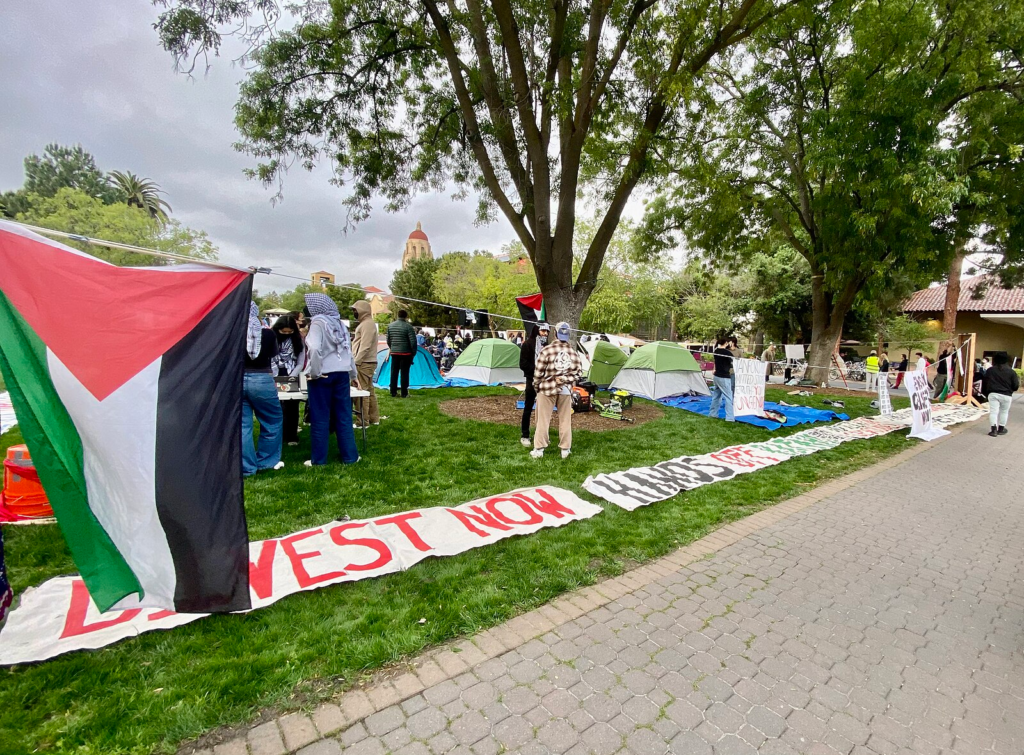Stanford Hunger Strikes

By: Laila Ali / Arab America Contributing Writer
For 24 days, Stanford students and faculty placed their bodies on the line, refusing food in protest of their university’s financial and political ties to Israel’s ongoing assault on Gaza. The hunger strike, which began on May 12 and ended June 5—the final day of spring quarter classes—has been called the longest such protest for Palestinian liberation in U.S. campus history.
Launched by Arab American and Muslim students and supported by a broad, multiracial coalition of allies, the Stanford hunger strike was a powerful act of civil disobedience rooted in grief, solidarity, and desperation. Participants endured dangerous health declines: some lost more than 10% of their body weight, with dangerously low blood glucose levels, dizziness, and extreme fatigue. One student described “falling asleep every five minutes” on the fourth day.
Their demands included that Stanford divest from companies supplying weapons and surveillance technologies used in Gaza, reverse new protest restrictions, drop disciplinary charges against earlier encampment participants, and issue a public statement condemning the siege in Gaza—where the U.N. recently reported over 14,000 children at risk of famine due to an Israeli blockade.
Yet despite students’ clear calls, Stanford’s leadership never engaged. “There is no new ground to cover,” wrote Vice Provost for Student Affairs Michele Rasmussen in a May 21 email on behalf of President Jonathan Levin and Provost Jenny Martinez. The response, students said, was emblematic of a broader institutional refusal to reckon with complicity in global injustice.
Sameeha ’25, a strike participant, called the university’s silence “dehumanizing,” asking, “How many people’s health has to deteriorate before the university will actually respond?”
The answer, it seems, was: all of them. On June 5, organizers ended the hunger strike, citing unresponsiveness from administrators but vowing to continue their movement. “We are stopping the hunger strike, but that doesn’t mean we’re going to stop pushing for what we want,” said Yousef Helal, a student organizer.
The National Context: From Harvard to Stanford
Stanford’s protest was part of a wave of campus activism for Palestinian liberation that has surged since October 2023, echoing historic movements like anti-apartheid divestment and Vietnam-era resistance. Among the first campuses to escalate to hunger striking was Harvard, where students launched a strike in early May. The Harvard organizers were immediately met with backlash—ranging from disciplinary warnings to intervention by the Trump-aligned federal government, which called the protests “antisemitic” and threatened university funding.
Despite that national pressure—and the threat of retaliation or arrest—students at Stanford pressed forward. They cited not only the urgency of famine in Gaza but the failure of traditional forms of advocacy. “There’s been two years of advocating every other way,” said Sara ’26. “It’s clear that we’re desperate for our university to show morality.”
Organizers were not alone. During the Stanford strike, support poured in from the Muslim Student Union, Black Action Contingent, Native Action Coalition, Stanford Asian American Action Committee, and even off-campus mosques and churches. Medical students monitored strikers’ vitals. Native allies offered symbolic necklaces, and community members packed daily rallies in White Plaza.
Sadia Orpa ’27, a history major, said she joined the strike to bridge the gap between classroom theory and real-world injustice. “I don’t want to see Palestine become another page in a history book that we mourn in hindsight,” she said. “Historical theories deserves to be applied.”
What Comes Next
Though the hunger strike has ended, the movement has not. Stanford Students for Justice in Palestine (SJP) has launched a summer “political education school” and plans to escalate actions when students return in the fall. With dozens of campuses nationwide staging encampments, hunger strikes, and direct actions, the fight for Palestinian justice is now one of the most visible youth-led movements in the U.S.
At Stanford, where students have now exhausted virtually every method of advocacy—sit-ins, divestment petitions, encampments, and now hunger strikes—the question is no longer whether students will keep pushing. It is whether institutions will ever answer.
“Our souls are with Gaza,” said Orpa. “That is why we showed up every day. And why we’ll keep showing up.”
Want more articles like this? Sign up for our e-newsletter!
Check out our blog here!








